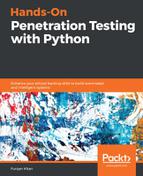Remember that when we discussed lists in the first chapter of the book, we mentioned that lists can actually hold heterogeneous data types in Python. A list may contain integers, strings, dictionaries, tuples, or even nested lists. This feature makes lists very powerful and exceptionally easy and intuitive to use. Let's take a look at the following example:
my_list=[1,"a",[1,2,3],{"k1":"v1"}]
my_list[0] -> 1
my_List[1] -> "a"
my_list[2] -> [1,2,3]
my_list[2][0] -> 1
my_list[2][2] -> 3
my_list[3] -> {"k1":"v1"}
my_list[3]["k1"] -> "v1"
my_list[3].get("k1") -> "v1
Let's take a closer look at while loops with the help of the following code, which we will call while_loops.py. We will also see how we can iterate over lists using while loops:

The first portion of the code, lines 2 to 6, depicts a simple usage of the while loop, where we are printing a statement five times. Note that the condition that is specified for the loop to be executed can be placed with or without braces, as shown from lines 7 to 10.
In line 12, we declared a list containing numbers, strings, a float, and a nested list as well. Then, in the final while loop starting at line 14, we iterate over the elements of the list by setting the loop control variable to be less than the length of the list. Within the loop, we check for the type of the list variable. The if type (1) returns an integer class, type (a) returns a string class, and type ([]) returns a list class. When the type is a list, we iterate over its elements again in a nested while loop, and print each one, as shown from lines 19 to 24:

